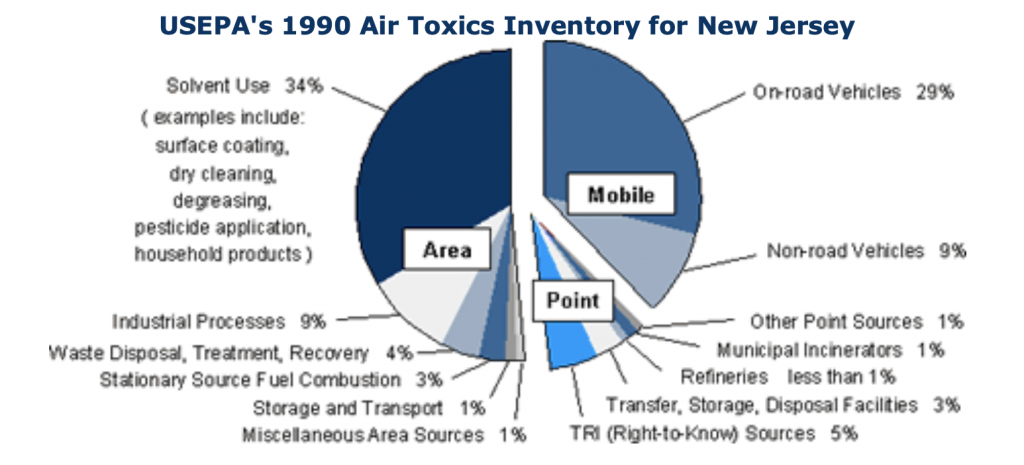Sources of Air Toxics – 1990 CEP
WHAT ARE POINT, NONPOINT, AND MOBILE SOURCES?
Air toxics are emitted from many types of sources. These sources of air pollution are generally categorized as point, nonpoint, and mobile (on-road and non-road) source. In the 1990 CEP, the Point, Area and Mobile Sources are grouped in the following way:
This list does not include many types of sources that are commonly referred to as Point Sources in New Jersey, such as power plants:
- Refineries
- Municipal Waste Incinerators
- Toxic Waste Transfer, Storage & Disposal Facilities (known as TSDFs)
- TRI Sources (those facilities that are required to report their emissions under the Right-to-Know program)
- Other Point Sources (that have reported emissions under other state and federal programs)
This list includes many types of sources that are commonly referred to as Point Sources in New Jersey, such as power plants:
- Solvent Use (such as coating cans, cleaning metal parts, and dry cleaning)
- Industrial Processes (such as small chemical manufacturing plants, bakeries, and making scrap metal into new product)
- <span”>Waste Disposal, Treatment and Recovery (including wastewater treatment and various types of waste incineration)
- Stationary Source Fuel Combustion (including power plants, industrial and commercial boilers, and home heating)
- Storage and Transport (including gas stations and large gasoline terminals)
- Miscellaneous Sources (such as wildfires, structure fires, and crop orchard heaters)
Mobile Sources are divided into two categories:
- On-road mobile sources are vehicles found on roads and highways, including cars, trucks, buses, and motorcycles.
- Non-road mobile sources include aircraft, trains, lawnmowers, boats, dirt bikes, construction vehicles, farm equipment, leaf blowers, and more.
THE NATIONAL AIR TOXICS EMISSIONS INVENTORY
As part of the Cumulative Exposure Project (CEP), USEPA prepared a comprehensive list of air toxics emissions for the entire country in 1990. This is the first time that such a list (known as an emissions inventory) had ever been prepared on a national scale. Although there are bound to be some errors in the details of a massive undertaking such as this, a summary of the emissions inventory can give us some indication of what may be the most important sources of air toxic emissions in our state. As can be seen from the pie chart below, the group known as Area Sources accounts for more than half (52%) of the air toxics inventory with solvent use representing the biggest portion (34% of the whole inventory). Mobile Sources as a group are the second largest contributor to air toxics (38%), with On-road Vehicles representing 29% of the whole state inventory. The Point Source group accounts for the remaining 10% of the inventory.

Note that this pie chart does not include emissions of diesel particulate matter. For a discussion of diesel emissions, click here.
COMPARISON OF EMISSIONS BY COUNTY
When the New Jersey emissions estimates are broken down by county, it is evident that the areas with the greatest air toxic emissions are generally those with the largest population. This is directly related to high levels of vehicle use, residential fuel burning, solvent use, and other population-related activities in those counties.

Note: The high emissions shown for Salem County in this chart are skewed by an error in the Industrial Processes source category. US EPA has confirmed that this could lead to overprediction of some toxic exposures in Salem County (by as much as 80 percent).
POLLUTANTS WITH SIGNIFICANT CONCENTRATIONS FROM BACKGROUND & TRANSFORMATION
Concentrations of some air toxics are dominated not by local emissions, but by atmospheric transformation (or secondary formation) and by what USEPA refers to as background estimates.
Secondary formation, or atmospheric transformation, occurs when chemicals are transformed into other chemicals in the atmosphere. When a chemical is transformed, the original pollutant no longer exists and is replaced by one or more new chemicals. A chemical that transformed from other pollutants can be more, less, or equally toxic to its precursors. Transformations and removal processes affect both the fate of a pollutant and its atmospheric persistence. EPA’s AirToxScreen uses secondary formation and atmospheric transformation interchangeably.
Formaldehyde is New Jersey’s primary air toxic of concern from secondary formation.
Background concentrations are existing levels of pollutants from natural sources, non-industrial human activities, and out of state industrial facilities. EPA describes background ambient air concentrations as values averaged over broad geographic regions. Background concentrations can account for pollutant concentrations found even without recent human-caused emissions.
Carbon tetrachloride is consistently considered an air toxic of concern in New Jersey, with estimated statewide average background concentrations exceeding the health benchmark.